Search results for: 'den'
-
 Egyptian ushabti from the Third Intermediate Period
Egyptian ushabti from the Third Intermediate PeriodFunerary statuette of faience with black paint. The opposed hands might indicate Tanis as origin. Third Intermediate Period of Ancient Egypt.
Price: on request Egyptian shabti
Egyptian shabtiFunerary statuette of faience. The opposed hands might indicate Tanis as origin. Third Intermediate Period of Ancient Egypt.
Price: on request Uschebti, ägyptische Totenfigur
Uschebti, ägyptische TotenfigurSchöne mintgrüne Fayence, erkennbare Gesichtszüge. Höhe 85mm. 26. - 30. Dynastie, Spätzeit.
Price: on request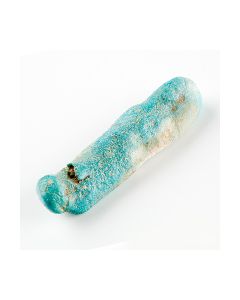 Uschebti aus Fayence
Uschebti aus FayenceÄgyptische Totenfigur, Uschebti, aus der Spätzeit bis ptolemäischen Zeit des Alten Ägypten. Mit schöner intensiv türkisfarbener Fayence.
Price: on request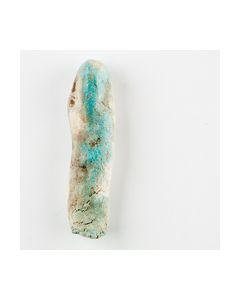 Uschebti aus Fayence
Uschebti aus FayenceÄgyptische Totenfigur, Uschebti, aus der Spätzeit bis ptolemäischen Zeit des Alten Ägypten. Mit schöner intensiv türkisfarbener Fayence.
Price: on request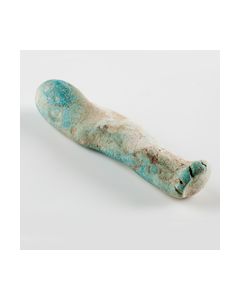 Uschebti aus Fayence
Uschebti aus FayenceÄgyptische Totenfigur, Uschebti, aus der Spätzeit bis ptolemäischen Zeit des Alten Ägypten. Mit schöner intensiv türkisfarbener Fayence.
Price: on request Egyptian ushabti for Ra-mes
Egyptian ushabti for Ra-mesThe mummiform funerary figurine dates to the Late Period of ancient Egypt, 26th to 31st dynasty. It is remarkable that it probably originates from the burial of two brothers, Ra-mes and Somtus-tefnacht.
Price: on request Ushabti for Ra-mes
Ushabti for Ra-mesThe mummiform funerary figurine dates to the Late Period of ancient Egypt, 26th to 31st dynasty. It is remarkable that it probably originates from the burial of two brothers, Ra-mes and Somtus-tefnacht.
Price: on request Egyptian ushabti for Somtus-tefnacht
Egyptian ushabti for Somtus-tefnachtThe mummiform funerary figurine dates to the Late Period of ancient Egypt, 26th to 31st dynasty. It is remarkable that it probably originates from the burial of two brothers, Somtus-tefnacht and Somtus-tefnacht.
Price: on request Egyptian ushabti for Somtus-tefnacht
Egyptian ushabti for Somtus-tefnachtThe mummiform funerary figurine dates to the Late Period of ancient Egypt, 26th to 31st dynasty. It is remarkable that it probably originates from the burial of two brothers, Somtus-tefnacht and Somtus-tefnacht.
Price: on request Egyptian ushabti for Somtus-tefnacht
Egyptian ushabti for Somtus-tefnachtThe mummiform funerary figurine dates to the Late Period of ancient Egypt, 26th to 31st dynasty. It is remarkable that it probably originates from the burial of two brothers, Somtus-tefnacht and Somtus-tefnacht.
Price: on request Ushabti for Somtus-tefnacht
Ushabti for Somtus-tefnachtThe mummiform funerary figurine dates to the Late Period of ancient Egypt, 26th to 31st dynasty. It is remarkable that it probably originates from the burial of two brothers, Somtus-tefnacht and Somtus-tefnacht.
Price: on request Egyptian ushabti for Somtus-tefnacht
Egyptian ushabti for Somtus-tefnachtThe mummiform funerary figurine dates to the Late Period of ancient Egypt, 26th to 31st dynasty. It is remarkable that it probably originates from the burial of two brothers, Somtus-tefnacht and Somtus-tefnacht.
Price: on request Egyptian ushabti for Somtus-tefnacht
Egyptian ushabti for Somtus-tefnachtThe mummiform funerary figurine dates to the Late Period of ancient Egypt, 26th to 31st dynasty. It is remarkable that it probably originates from the burial of two brothers, Somtus-tefnacht and Somtus-tefnacht.
Price: on request Egyptian ushabti for Somtus-tefnacht
Egyptian ushabti for Somtus-tefnachtThe mummiform funerary figurine dates to the Late Period of ancient Egypt, 26th to 31st dynasty. It is remarkable that it probably originates from the burial of two brothers, Somtus-tefnacht and Somtus-tefnacht.
Price: on request Egyptian ushabti for Ra-mes
Egyptian ushabti for Ra-mesThe mummiform funerary figurine dates to the Late Period of ancient Egypt, 26th to 31st dynasty. It is remarkable that it probably originates from the burial of two brothers, Ra-mes and Somtus-tefnacht.
Price: on request Polychromic sarcophagus mask from Ancient Egypt
Polychromic sarcophagus mask from Ancient EgyptBemalte Holzmaske aus ptolemäischer Zeit. Kunstvoller Sarkophagschmuck in museumswürdiger Erhaltung. Ca. 18cm lang, 11cm breit.
Price: on request Skaraboides Stempelsiegel
Skaraboides StempelsiegelÄgyptisches Stempelsiegel-Amulett in der stark stilisierten Form eines Skarabäuskäfers. Die Stempelfläche trägt eine symbolische Verzierung. 1. Jt. v. Chr.
Price: on request Uschebti der Herrin des Hauses
Uschebti der Herrin des HausesÄgyptischer Uschebti für seine Besitzerin mit dem Titel Herrin des Hauses. Aus der Dritten Zwischenzeit des Alten Ägyptens. Kopf mit dreigeteilter Perücke und dem für die Zeit typischen Haarband (sheshed).
Price: on request Ägyptischer Ushebti mit T-förmiger Inschrift
Ägyptischer Ushebti mit T-förmiger InschriftTotenfigur aus mintfarbener Fayence mit hieroglyphischer Inschrift, 28. bis 30. Dynastie, Spätzeit. 105mm hoch.
Price: on request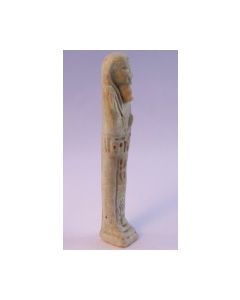 Uschebti des Ptahhotep
Uschebti des PtahhotepÄgyptische Statuette in musealer Erhaltung. 400 bis 332 v.Chr., Spätzeit, 28. bis 30. Dynastie. 10cm hoch. Mit Hieroglyphentext: Der erleuchtete Osiris, Herr der Kraft, Gottes Diener, Ptahhotep, ...
Price: on request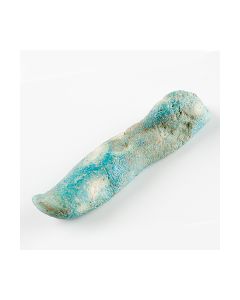 Uschebti aus Fayence
Uschebti aus FayenceÄgyptische Totenfigur, Uschebti, aus der Spätzeit bis ptolemäischen Zeit des Alten Ägypten. Mit schöner intensiv türkisfarbener Fayence.
Price: on request Scarab with sphinx
Scarab with sphinxThe stamp depicts a human headed sphinx walking towards the Ankh symbol of life. The amulet should exert a protective function on the one carrying or owning it.
Price: on request Scarab with sphinx
Scarab with sphinxThe stamp depicts a sphinx with pharaoh headcloth walking towards the Ankh symbol of life. The amulet should exert a protective function on the one carrying or owning it.
Price: on request Osirisstatuette aus Bronze
Osirisstatuette aus BronzeMuseales Stück mit wunderschöner, dunkler Patina. Ein sehr ähnliches, schlechter erhaltenes Stück ist im Metropolitan Museum of Arts ausgestellt.
Price: on request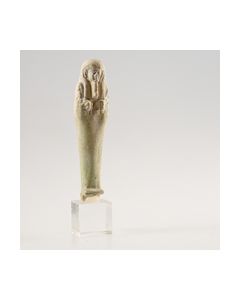 Ushebti des Wah-ib-Ra aus der Sammlung von Sir Flinders Petrie
Ushebti des Wah-ib-Ra aus der Sammlung von Sir Flinders PetrieInschrift: Osiris Wah-ib-ra, geboren von (Sohn der) Ta bzw. Tent-Pa. Exzellente Erhaltung, Hieroglyphen klar lesbar.
Price: on request Uschebti aus Holz, Neues Reich
Uschebti aus Holz, Neues ReichKörper deutlich tailliert. Kopf mit detiallierten Gesichtszügen. 19. bis 20. Dynastie. Eindrucksvolle 19cm hoch.
Price: on request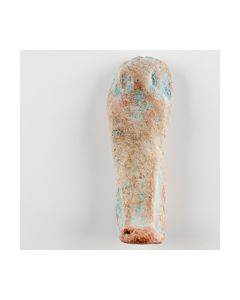 Ushepti mit Kern aus Ton, 22. bis 25. Dynastie
Ushepti mit Kern aus Ton, 22. bis 25. DynastieÄgyptische Totenfigur aus der 3. Zwischenzeit. Seltener Typ mit Tonkern und imitierter Fayence auf weißem Grund. Interessantes Belegstück für einen Übergangsstil.
Price: on request Ushepti mit Kern aus Ton, 22. bis 25. Dynastie
Ushepti mit Kern aus Ton, 22. bis 25. DynastieÄgyptische Totenfigur aus der 3. Zwischenzeit. Seltener Typ mit Tonkern und imitierter Fayence auf weißem Grund. Interessantes Belegstück für einen Übergangsstil.
Price: on request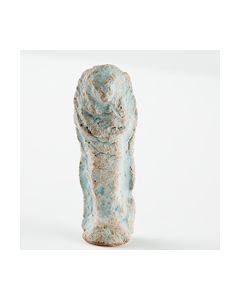 Ushepti mit Kern aus Ton, 22. bis 25. Dynastie
Ushepti mit Kern aus Ton, 22. bis 25. DynastieÄgyptische Totenfigur aus der 3. Zwischenzeit. Seltener Typ mit Tonkern und imitierter Fayence auf weißem Grund. Interessantes Belegstück für einen Übergangsstil.
Price: on request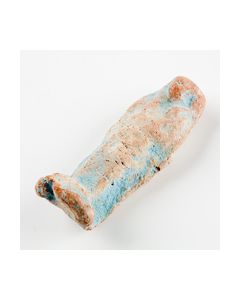 Ushepti mit Kern aus Ton, 22. bis 25. Dynastie
Ushepti mit Kern aus Ton, 22. bis 25. DynastieÄgyptische Totenfigur aus der 3. Zwischenzeit. Seltener Typ mit Tonkern und imitierter Fayence auf weißem Grund. Interessantes Belegstück für einen Übergangsstil.
Price: on request Amulett des Bes aus der 18. Dynastie
Amulett des Bes aus der 18. DynastiePlastisches Relief des stehenden Gottes für Musik und Tanz. Bes war darüber hinaus auch Beschützer der Kinder und Schwangeren. Dieser Funktion diente vermutlich auch das Amulett.
Price: on request Fayenceziegel vom Typ der Djoser-Pyramide
Fayenceziegel vom Typ der Djoser-PyramideÄgyptischer Ziegel aus dem Alten Reich, 2. bis 3. Dynastie, intensiv-türkisfarbene Fayence. Ziegelform bekannt aus der berühmten Stufenpyramide von Djoser.
Price: on request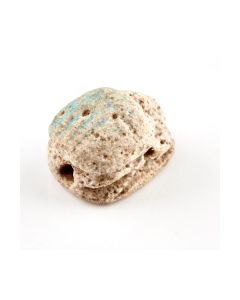 Ägyptischer Skarabäus
Ägyptischer SkarabäusStilisierte Form eines Skarabäuskäfers. Die Stempelfläche trägt Hieroglyphen. 1. Jt. v. Chr.
Price: on request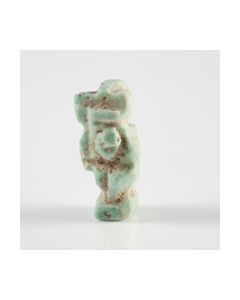 Ägyptisches Amulett der Taweret - Schutzgöttin der Schwangeren
Ägyptisches Amulett der Taweret - Schutzgöttin der SchwangerenMintgrüne Fayence. Spätzeit, Altes Ägypten, 26. bis 30. Dynastie. Hervorragender Zustand. Vollständig intakt.
Price: on request Ägyptisches Herzamulett
Ägyptisches Herzamulettca. 946 v. Chr. bis 30 v. Chr. Museale Erhaltung, schöne Patina. Schönes Belegstück eines Herzamuletts.
Price: on request

